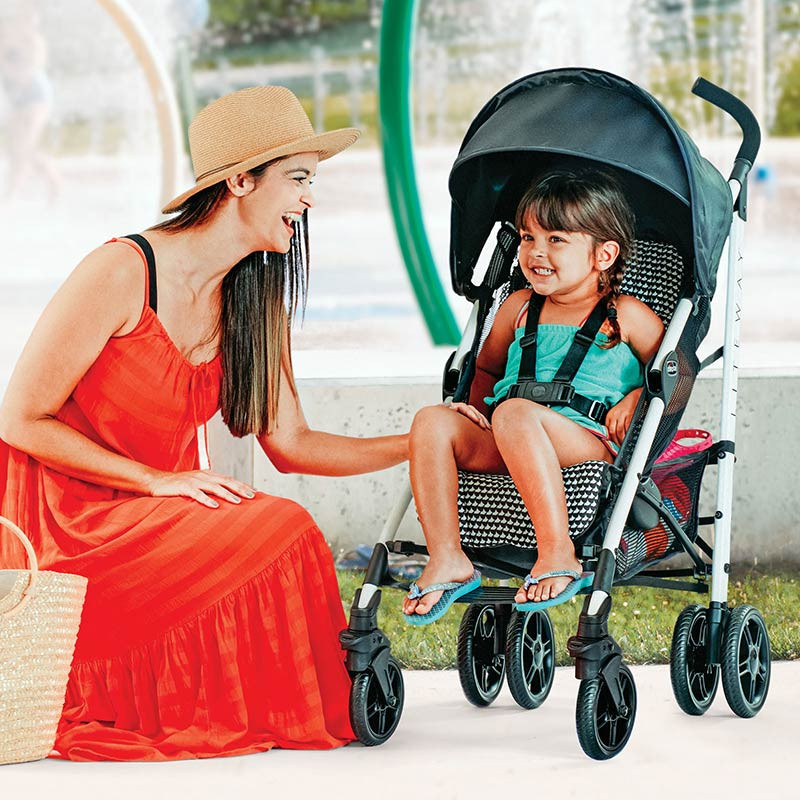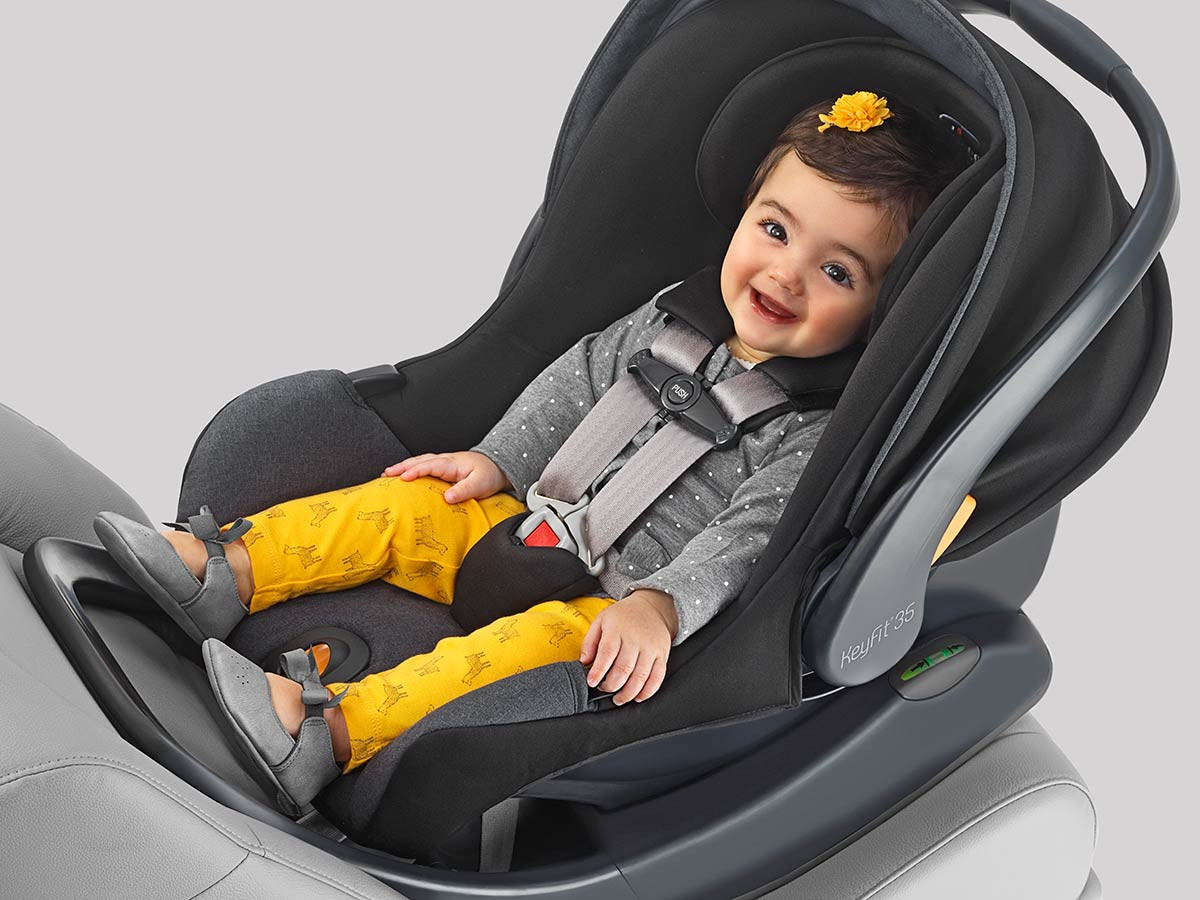Flying with a stroller can seem daunting, but with careful planning and the right knowledge, it can be a smooth experience. At flyermedia.net, we offer expert advice to help parents navigate air travel with ease, ensuring their little ones are comfortable and secure. Discover simple strategies for stress-free travel with children, and access detailed airline policies to ensure you’re well-prepared for your next journey with a baby or toddler.
1. Why Bring a Stroller When You Fly?
 Chicco Liteway Lightweight Stroller
Chicco Liteway Lightweight Stroller
Bringing a stroller when you fly offers numerous advantages, especially when traveling with young children. A stroller simplifies navigating airports, offering a convenient way to transport your child and carry essential items.
Detailed Explanation:
- Airport Navigation: Airports involve significant walking distances. A stroller allows you to move swiftly through terminals, especially during layovers or when connecting to different gates.
- Convenience: Strollers provide a comfortable place for your child to sit or nap while waiting in lines or at the gate. They also reduce the strain of carrying a child for extended periods.
- Storage: Strollers often come with storage baskets, which can be used to carry diaper bags, snacks, and other travel essentials, freeing up your hands.
- Destination Use: Once you arrive at your destination, a stroller is invaluable for outings, sightseeing, and navigating crowded tourist spots.
According to a study by the FAA, using strollers and child restraint systems can greatly enhance the safety and convenience of air travel for families.
2. Is Bringing a Car Seat on a Plane Necessary?
While not always mandatory, bringing a car seat on a plane is highly recommended by both the American Academy of Pediatrics and the FAA for young children. Using a car seat ensures your child’s safety and comfort during the flight.
Detailed Explanation:
- Safety: Car seats provide a familiar and secure environment for your child, minimizing movement during turbulence and potential injuries.
- FAA Recommendation: The FAA advises using a child safety restraint system (car seat) for children who weigh 40 pounds or less. Car seats must be FAA-approved to be used on airplanes.
- Consistent Use: Using the same car seat in the airplane and rental car eliminates the need to adjust your child to an unfamiliar restraint.
- Hygiene and Familiarity: Renting car seats at your destination can expose your child to unknown cleanliness standards and unfamiliar equipment. Bringing your own ensures a clean and comfortable experience.
According to research from Embry-Riddle Aeronautical University, in July 2025, using FAA-approved car seats during flights significantly reduces the risk of injury to young children.
3. What are 7 Essential Tips for Flying with a Stroller and Car Seat?
 Chicco KeyFit 35 Infant Car Seat
Chicco KeyFit 35 Infant Car Seat
To ensure a smooth and stress-free journey, here are seven essential tips for flying with a stroller and car seat:
- Check Airline Regulations: Every airline has specific rules regarding the size and type of strollers and car seats allowed. Always check with your airline before your trip.
- Remove Unnecessary Attachments: Detach any toys, straps, or accessories from your stroller and car seat to prevent damage or loss.
- Get Luggage Tags Early: Attach luggage tags to your stroller and car seat as soon as you arrive at the gate, even if you are not boarding immediately.
- Ensure FAA Approval: If you plan to use the car seat on the plane, verify that it has an FAA-approved sticker.
- Review Installation Instructions: Familiarize yourself with the car seat’s installation instructions for use on an airplane.
- Know the Landing Plan: Research how and where you will collect your checked items after landing to avoid confusion.
- Have Alternate Plans: Prepare for potential issues like damage or loss by researching replacement options at your destination.
Expanded Advice:
- Airline Compliance: Ensure your stroller and car seat meet the airline’s compliance standards for flying.
- Travel Bags: Consider using a car seat travel bag to protect your car seat from damage and keep it clean.
- Bonus Tip: Bring a sling or wearable baby carrier for easier navigation through the airport, especially if your stroller or car seat is delayed.
4. What Airline Policies Should I Know for Strollers and Car Seats?
Airline policies vary, so understanding each airline’s specific regulations for strollers and car seats is crucial. Below is a summary of the policies of major U.S. airlines.
| Airline | Stroller Policy | Car Seat Policy |
|---|---|---|
| Alaska Airlines | Check free at gate or ticket counter. | May use in adjacent empty seat if available; otherwise, check free of charge. |
| American Airlines | Each adult can check one stroller free. Smaller strollers can be gate-checked; larger ones at the ticket counter. | To carry on, you must have purchased a seat or have a free seat next to yours. If there is not an empty seat next to you, a flight attendant will check the car seat to your final destination. |
| Delta | Check free at curb, gate, or ticket counter. | FAA-approved car seat can be used if traveling with a lap infant and there is an empty seat next to you. If there’s no free seat near you, the flight attendant will check it to your destination. |
| Frontier | Strollers can be checked for free at the gate, and FAA-approved car seats can be used if you’ve purchased a seat for it. | FAA-approved car seats can be used if you’ve purchased a seat. Frontier recommends placing car seats in window seats to avoid blocking the aisle. |
| Hawaiian | Strollers can be checked for free, but non-collapsible or large strollers (50 pounds or more) must be checked. | Rear-facing, FAA-approved car seats can be used if you’ve purchased a seat for your child. The car seat will not count as a carry-on item in this case. |
| jetBlue | Strollers, car seats, child carriers/backpacks, and booster car seats can all be checked for free at the gate or ticket counter. | Not all seats can accommodate some car seats, so check with them in advance. |
| Southwest | One stroller per child can be checked at the curb, gate, or ticket counter for free. | Southwest offers infant fares that allow you to purchase a seat for your baby to sit in an FAA-approved car seat. |
| Spirit | Spirit permits one stroller per child checked free of charge, as well as a double stroller for two children. | If you are using a car seat and did not pay for an assigned seat and the seats do not fit the car seat, the airline will try its best to move the parents and child in an aisle that will accommodate the seat, excluding Big Front Seats. |
| United | United permits checking a stroller or foldable wagon for each child at the ticket counter or gate at no additional charge. Small, collapsible strollers can be brought on board free of charge and stowed in the overhead compartments. | United does not reserve space for FAA-approved child seats unless a ticket has been purchased for that seat. If space is available after boarding is completed, customers may use adjacent unused seats for car seats. If space is not available after boarding is completed, the item must be stowed in an approved storage space. |
This table provides a quick reference to help you prepare for your flight. Always verify the latest policies with the airline directly.
5. How Can I Simplify Getting Through Airport Security?
 Chicco Car Seat Travel Bag at Airport
Chicco Car Seat Travel Bag at Airport
Navigating airport security with a stroller and car seat can be streamlined with a few strategies. Families frequently on the move may consider purchasing a travel system or car seat travel bag to carry their car seat.
Streamlining Strategies:
- TSA PreCheck: Consider applying for TSA PreCheck to expedite your journey through airport security, allowing you to avoid removing liquids and electronics from your bags.
- Travel Systems: Use travel systems featuring car seats that connect directly to the stroller, making it easier to move through the airport after checking in with TSA.
- Gate Checking: During boarding, your airline should allow you to gate-check the stroller and board with the car seat.
- Pack Smart: Organize your carry-on bags to easily access items needed for security checks, such as liquids and electronics.
Additional Tips:
- Wear easily removable shoes to speed up the screening process.
- Dress your child in comfortable, easy-to-remove clothing.
- Allow extra time to get through security, reducing stress and ensuring a smoother experience.
6. What are The Benefits of Using a Car Seat Travel Bag?
 Chicco Car Seat Travel Bag
Chicco Car Seat Travel Bag
Using a car seat travel bag offers several benefits for protecting and transporting your car seat during air travel. A durable travel bag prevents damage and keeps the car seat clean.
Benefits of a Car Seat Travel Bag:
- Protection: Car seat travel bags protect your car seat from dirt, scratches, and other damage during transit.
- Convenience: Many car seat travel bags come with wheels and handles, making it easier to maneuver through the airport.
- Organization: Travel bags help keep all car seat components together, preventing loss of parts during travel.
- Water Resistance: Waterproof travel bags protect the car seat from spills and moisture.
Types of Car Seat Travel Bags:
- Standard Car Seat Travel Bag: A basic bag designed to protect the car seat during travel.
- Padded Car Seat Travel Bag: Includes extra padding for enhanced protection.
- Wheeled Car Seat Travel Bag: Equipped with wheels for easy transport.
- Convertible Car Seat Travel Bag: Designed to fit both infant and convertible car seats.
7. How Do I Prepare for Potential Stroller or Car Seat Damage?
Even with careful planning, damage or loss of your stroller or car seat can occur. Prepare for these scenarios by researching replacement options at your destination.
Preparation Strategies:
- Research Local Retailers: Identify stores at your destination that sell strollers and car seats.
- Check Rental Services: Investigate rental services that offer strollers and car seats.
- Review Insurance Policies: Determine if your travel insurance covers damage or loss of baby equipment.
- Document Condition: Take photos of your stroller and car seat before the flight to document their condition.
Contingency Plans:
- Budget for Replacements: Set aside funds to cover the cost of a replacement stroller or car seat.
- Contact Airline: If your items are damaged during the flight, immediately file a claim with the airline.
- Use a Baby Carrier: Keep a baby carrier handy as a backup for moving through the airport and your destination.
8. What Should I Know About FAA Approval for Car Seats?
Understanding FAA approval for car seats is vital for ensuring your child’s safety on a plane. Car seats used on airplanes must meet specific safety standards and display an FAA-approved sticker.
Key Points:
- FAA Sticker: Look for a sticker with red lettering stating, “This restraint is certified for use in motor vehicles and aircraft.”
- Compatibility: Ensure the car seat fits in the airplane seat, which is typically 16 inches wide.
- Prohibited Seats: Booster seats are not certified for use on airplanes, including all-in-one models in booster mode.
- Emergency Exits: Car seats are not allowed in emergency exit rows and cannot block other passengers from exiting.
Verification Steps:
- Check Before Travel: Verify that the FAA approval sticker is on the car seat well before heading to the airport.
- Consult Manual: Keep your car seat manual handy for installation instructions and additional proof of suitability for airplane use.
- Inform Flight Attendant: Be prepared to show the FAA approval sticker to the flight attendant upon request.
9. How Do I Install a Car Seat on a Plane?
Properly installing a car seat on an airplane ensures your child’s safety and comfort during the flight. Follow the manufacturer’s instructions and airline guidelines for secure installation.
Installation Steps:
- Position the Car Seat: Place the car seat in a forward-facing position unless otherwise specified in the manual.
- Thread the Seat Belt: Route the airplane seat belt through the designated slots on the car seat.
- Tighten the Seat Belt: Securely tighten the seat belt, ensuring the car seat is firmly in place.
- Check for Movement: Ensure the car seat does not move more than one inch in any direction.
- Consult Manual: Refer to your car seat manual for specific instructions related to airplane installation.
Additional Tips:
- Practice at Home: Practice installing the car seat in advance to familiarize yourself with the process.
- Seek Assistance: If you need help, ask a flight attendant for assistance.
- Rear-Facing Seats: For infant car seats, ensure the base is not used on the plane unless specifically approved in the manual.
10. How Can flyermedia.net Help Me Fly with a Stroller?
At flyermedia.net, we provide a comprehensive resource for all your air travel needs. We can assist you in finding the best information about flying with strollers, including airline policies, safety tips, and product recommendations.
Services Provided:
- Expert Guides: Access detailed guides on How To Fly With Strollers and car seats, ensuring a smooth and stress-free journey.
- Airline Policy Updates: Stay informed with the latest airline policies regarding strollers and car seats.
- Product Recommendations: Discover top-rated car seats, strollers, and travel accessories for your travel needs.
- Travel Tips: Get valuable travel tips and strategies for navigating airports with children.
Call to Action:
Visit flyermedia.net today to explore our resources and make your next flight with a stroller a breeze. Contact us at 600 S Clyde Morris Blvd, Daytona Beach, FL 32114, United States, or call us at +1 (386) 226-6000.
FAQ About Flying With a Stroller
1. Can I bring a stroller and car seat on a plane for free?
Yes, most airlines allow you to check a stroller and car seat for free, either at the gate or the ticket counter. However, policies vary, so it’s best to check with your specific airline beforehand.
2. What type of stroller is best for flying?
A lightweight, collapsible stroller is ideal for flying. These strollers are easy to carry and store in overhead compartments or gate-check.
3. Do I need a special bag for my car seat when flying?
While not mandatory, using a car seat travel bag is highly recommended. It protects your car seat from damage and keeps it clean during transit.
4. Can I use my car seat on the plane?
Yes, if your car seat is FAA-approved. Look for a sticker on the car seat indicating it is certified for use in motor vehicles and aircraft.
5. What should I do if my stroller is damaged during the flight?
File a claim with the airline immediately. Take photos of the damage and keep all documentation related to your flight.
6. Is it better to gate-check my stroller or check it at the ticket counter?
Gate-checking is generally more convenient, as you can use the stroller until you board the plane. However, larger strollers may need to be checked at the ticket counter.
7. How can I make airport security easier with a stroller?
Consider applying for TSA PreCheck to expedite the security process. Also, pack smart and be prepared to remove any items required by TSA.
8. Are booster seats allowed on airplanes?
No, booster seats are not certified for use on airplanes. Only FAA-approved car seats are permitted.
9. What size car seat is allowed on an airplane?
Most coach airplane seats are about 16 inches wide, so ensure your car seat fits within these dimensions.
10. Where can I find the FAA approval sticker on my car seat?
The FAA approval sticker is usually located on the side or back of the car seat. Look for red lettering indicating the car seat is certified for use in motor vehicles and aircraft.
